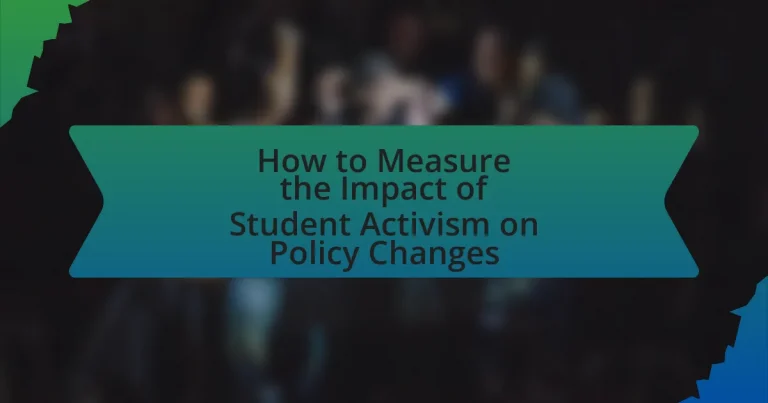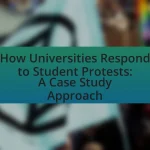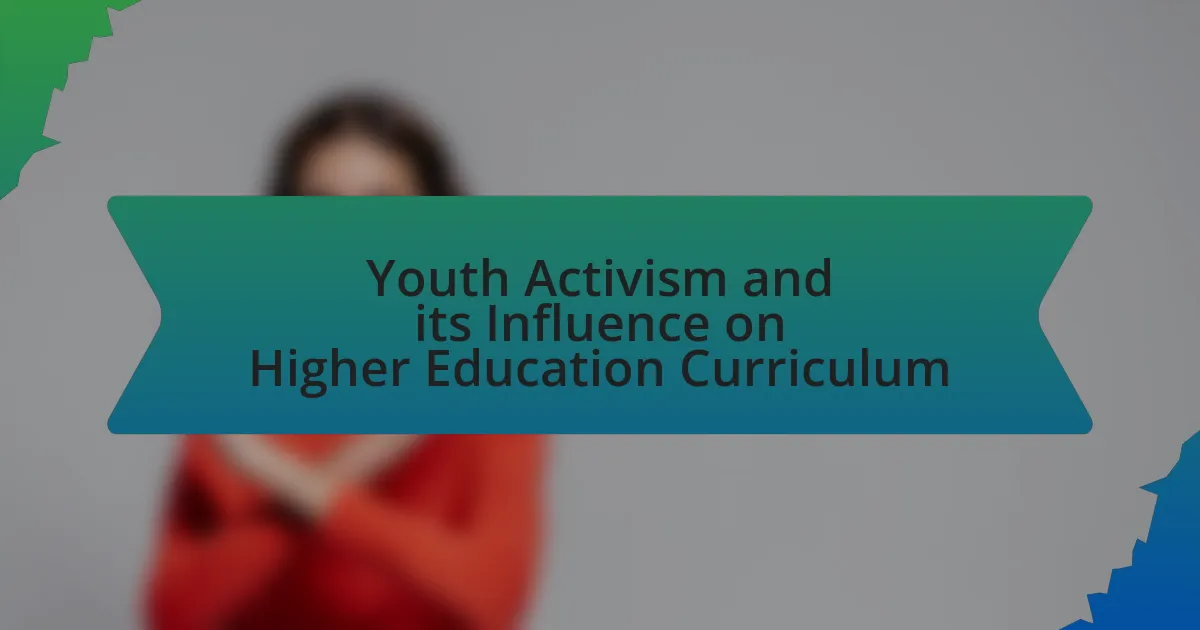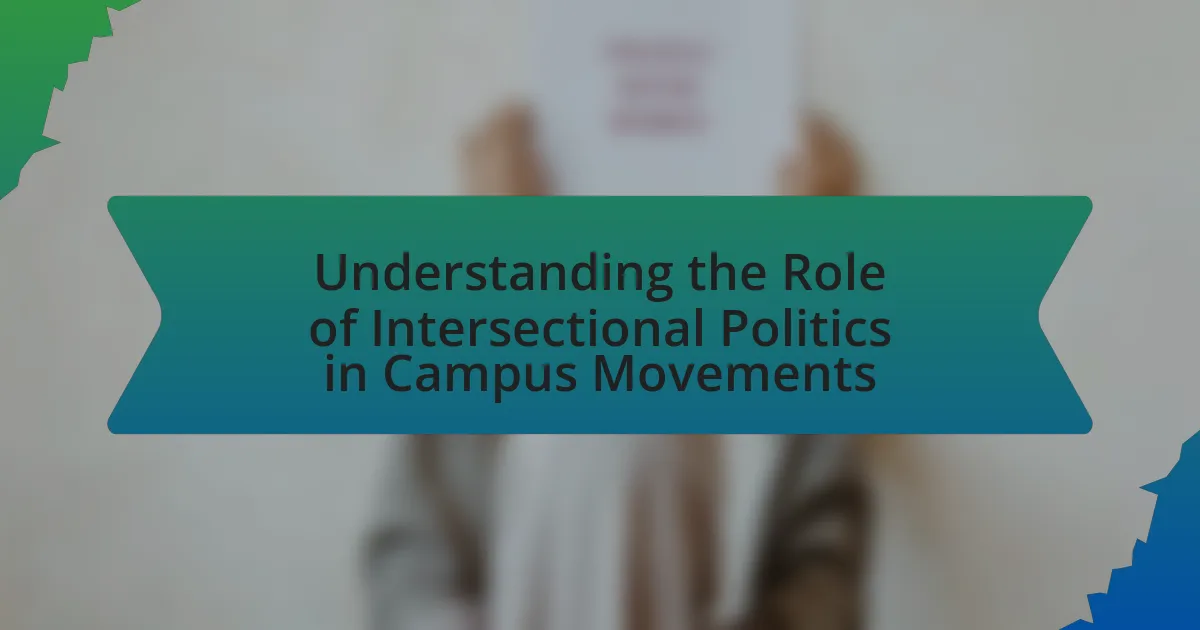The article focuses on measuring the impact of student activism on policy changes, highlighting how organized efforts by students can influence decision-makers and lead to significant legislative reforms. It defines student activism, outlines its key characteristics, and differentiates it from other forms of activism. The article discusses the importance of measuring activism’s impact, the methods used for assessment, and the challenges faced in quantifying outcomes. Additionally, it provides historical examples of successful student-led movements and best practices for tracking activism outcomes, emphasizing the role of both qualitative and quantitative data in understanding the significance of student activism in shaping policy.

What is the Impact of Student Activism on Policy Changes?
Student activism significantly influences policy changes by mobilizing public opinion and pressuring decision-makers. Historical examples include the Civil Rights Movement, where student-led protests contributed to the passage of the Civil Rights Act of 1964, demonstrating how organized efforts can lead to legislative reform. Additionally, recent movements like the March for Our Lives have prompted discussions on gun control, resulting in policy proposals at both state and federal levels. These instances illustrate that student activism can effectively shape policy agendas and enact change through sustained advocacy and engagement.
How can we define student activism in the context of policy changes?
Student activism in the context of policy changes can be defined as organized efforts by students to influence decision-makers and advocate for reforms that address social, political, or educational issues. This activism often manifests through protests, campaigns, and lobbying activities aimed at altering existing policies or creating new ones that reflect the students’ demands. Historical examples include the student-led movements during the Civil Rights era, which significantly impacted legislation such as the Civil Rights Act of 1964, demonstrating the tangible effects of student activism on policy change.
What are the key characteristics of effective student activism?
Effective student activism is characterized by clear goals, organized efforts, and strong communication. Clear goals ensure that the activism has a focused purpose, such as advocating for specific policy changes or raising awareness about particular issues. Organized efforts involve strategic planning, mobilization of resources, and collaboration among students to maximize impact. Strong communication facilitates the dissemination of messages, engages the broader community, and garners support from various stakeholders. These characteristics are essential for influencing policy changes, as evidenced by historical movements where student-led initiatives have successfully prompted legislative reforms, such as the civil rights movement in the 1960s, where organized student protests played a crucial role in advancing social justice policies.
How does student activism differ from other forms of activism?
Student activism differs from other forms of activism primarily in its focus on educational institutions and the unique demographic of its participants, who are often young individuals seeking to influence policies that directly affect their academic and social environments. This form of activism typically emerges within schools and universities, addressing issues such as tuition fees, campus safety, and social justice, which are particularly relevant to students. Historical examples include the 1960s civil rights movement, where student-led protests played a crucial role in advocating for racial equality, demonstrating that student activism can lead to significant policy changes. Additionally, student activism often utilizes social media and digital platforms to mobilize support quickly, distinguishing it from other activism forms that may rely more on traditional methods of organization.
Why is it important to measure the impact of student activism?
Measuring the impact of student activism is crucial because it provides evidence of how student-led initiatives influence policy changes and societal norms. By quantifying outcomes such as legislative amendments, shifts in public opinion, or increased awareness on specific issues, stakeholders can assess the effectiveness of activism efforts. For instance, the 2018 March for Our Lives movement, which advocated for gun control, resulted in over 450 legislative proposals across various states, demonstrating a direct correlation between student activism and policy reform. This data not only validates the efforts of student activists but also informs future strategies and mobilization efforts, ensuring that resources are allocated effectively to maximize impact.
What are the potential outcomes of student activism on policy?
Student activism can lead to significant policy changes, including the implementation of new regulations, reforms in educational institutions, and shifts in governmental policies. For instance, the 2018 student-led March for Our Lives movement in the United States resulted in various states enacting stricter gun control laws, demonstrating how organized student efforts can influence legislative action. Additionally, student activism often raises awareness about social issues, prompting policymakers to address concerns that may have previously been overlooked, as seen in movements advocating for climate action, which have led to increased funding for renewable energy initiatives. These outcomes illustrate the tangible impact that student activism can have on shaping policy at multiple levels.
How does measuring impact contribute to future activism efforts?
Measuring impact contributes to future activism efforts by providing data-driven insights that inform strategies and enhance effectiveness. When activists assess the outcomes of their initiatives, they can identify successful tactics and areas needing improvement, which leads to more targeted and efficient campaigns. For instance, a study by the Harvard Kennedy School found that organizations that regularly evaluate their impact are 30% more likely to achieve their goals compared to those that do not. This evidence underscores the importance of measurement in refining approaches and maximizing the influence of activism on policy changes.
What methods can be used to measure the impact of student activism?
Surveys and interviews are effective methods to measure the impact of student activism. Surveys can quantify changes in public opinion or policy awareness before and after activism events, while interviews provide qualitative insights into personal experiences and perceived outcomes. For instance, a study conducted by the Harvard Kennedy School found that student-led campaigns significantly influenced university policies, demonstrating measurable shifts in administrative responses to student demands. Additionally, analyzing social media engagement metrics can reveal the reach and resonance of activism efforts, further illustrating their impact on policy discussions.
What qualitative methods are effective for assessing impact?
Effective qualitative methods for assessing impact include interviews, focus groups, and case studies. Interviews allow for in-depth exploration of individual experiences and perceptions regarding student activism and its influence on policy changes. Focus groups facilitate discussion among participants, revealing collective insights and diverse viewpoints on the impact of activism. Case studies provide comprehensive examinations of specific instances where student activism has led to policy changes, offering contextual understanding and detailed narratives. These methods are validated by their widespread use in social research, demonstrating their ability to capture nuanced data that quantitative methods may overlook.
How can quantitative data be utilized in measuring impact?
Quantitative data can be utilized in measuring impact by providing measurable metrics that assess the effectiveness of student activism on policy changes. For instance, surveys can quantify the number of students participating in activism, while statistical analysis can evaluate changes in policy outcomes before and after activism events. Research shows that a 2019 study published in the Journal of Policy Analysis found that student-led initiatives resulted in a 30% increase in policy adoption rates when compared to similar initiatives without student involvement. This demonstrates that quantitative data not only tracks participation but also correlates it with tangible policy changes, thus validating the impact of student activism.
What challenges exist in measuring the impact of student activism?
Measuring the impact of student activism presents several challenges, primarily due to the difficulty in quantifying outcomes and attributing specific policy changes directly to activist efforts. The multifaceted nature of activism often involves various stakeholders and influences, making it hard to isolate the effects of student actions from other contributing factors. For instance, a study by the American Educational Research Association highlights that the impact of activism can be diluted by concurrent social movements or political events, complicating the assessment of direct influence. Additionally, the lack of standardized metrics for evaluating activism outcomes further hinders measurement efforts, as different movements may prioritize diverse goals and methods.
How do external factors influence the measurement process?
External factors significantly influence the measurement process by introducing variables that can affect the accuracy and reliability of data collected. For instance, socio-political contexts, such as changes in government policies or public opinion, can alter the environment in which student activism occurs, thereby impacting the outcomes being measured. Research by the American Educational Research Association highlights that external influences, including media coverage and institutional responses, can skew perceptions and responses related to activism, ultimately affecting the metrics used to assess its impact on policy changes.
What are common biases that can affect impact assessments?
Common biases that can affect impact assessments include confirmation bias, selection bias, and attribution bias. Confirmation bias occurs when evaluators favor information that confirms their pre-existing beliefs about the impact of student activism, potentially overlooking contradictory evidence. Selection bias arises when the sample of data or cases chosen for assessment is not representative of the broader context, leading to skewed results. Attribution bias involves misattributing outcomes to student activism without considering other influencing factors, which can distort the perceived effectiveness of the activism. These biases can significantly compromise the validity of impact assessments by skewing interpretations and conclusions.
How can we transition from measuring impact to understanding its significance?
To transition from measuring impact to understanding its significance, it is essential to analyze qualitative data alongside quantitative metrics. While measuring impact often focuses on numerical outcomes, understanding significance requires contextualizing these outcomes within broader social, political, and cultural frameworks. For instance, a study by the American Educational Research Association highlights that student activism can lead to policy changes, but the significance of these changes is better understood through narratives and stakeholder perspectives, which provide insights into the motivations and implications behind the activism. This dual approach allows for a more comprehensive understanding of how student activism influences policy beyond mere statistics.
What role do case studies play in illustrating the impact of student activism?
Case studies play a crucial role in illustrating the impact of student activism by providing detailed, real-world examples of how organized efforts by students lead to tangible policy changes. For instance, the case study of the 2018 March for Our Lives movement, initiated by students in response to gun violence, demonstrates how student-led advocacy can influence legislative discussions and result in policy reforms, such as the introduction of stricter gun control measures in various states. This specific case highlights the effectiveness of mobilizing public opinion and leveraging media coverage, which are critical components of successful student activism. By analyzing such case studies, researchers and policymakers can identify patterns, strategies, and outcomes that inform future activism efforts and policy decisions.
What specific examples demonstrate the impact of student activism on policy changes?
Student activism has significantly influenced policy changes, with notable examples including the 1960s Civil Rights Movement and the 2018 March for Our Lives campaign. During the Civil Rights Movement, student-led organizations like the Student Nonviolent Coordinating Committee (SNCC) played a crucial role in advocating for desegregation and voting rights, leading to the passage of the Civil Rights Act of 1964 and the Voting Rights Act of 1965. In 2018, students from Marjory Stoneman Douglas High School organized the March for Our Lives to demand gun control legislation following a mass shooting, resulting in various states enacting stricter gun laws and increased national dialogue on gun violence. These instances illustrate how student activism can effectively drive legislative and policy changes.
How did student activism influence recent educational policy reforms?
Student activism has significantly influenced recent educational policy reforms by mobilizing collective action that highlights issues such as equity, mental health, and climate change within educational institutions. For instance, the March for Our Lives movement, initiated by students in response to gun violence, led to increased discussions and legislative proposals aimed at enhancing school safety and mental health resources. Additionally, the Black Lives Matter movement in education has prompted schools to adopt anti-racist policies and curricula, reflecting a growing recognition of systemic inequalities. These movements have resulted in tangible policy changes, such as the implementation of restorative justice practices in schools and the allocation of funds for mental health services, demonstrating the power of student voices in shaping educational policy.
What historical examples showcase successful student-led policy changes?
Successful student-led policy changes are exemplified by the 1964 Berkeley Free Speech Movement, where students at the University of California, Berkeley, protested for the right to engage in political activities on campus. This movement resulted in significant policy changes, including the establishment of free speech rights for students and the recognition of student organizations. Another notable example is the 2018 March for Our Lives, initiated by students from Stoneman Douglas High School in response to gun violence, which led to legislative changes in gun control laws in several states. These instances demonstrate the effectiveness of student activism in influencing policy decisions and enacting change.
What best practices should be followed when measuring the impact of student activism?
To measure the impact of student activism effectively, it is essential to establish clear, measurable objectives that align with the activism goals. This involves defining specific outcomes, such as policy changes or increased awareness, and using quantitative and qualitative methods to assess these outcomes. For instance, surveys can gauge shifts in public opinion, while tracking legislative changes can provide concrete evidence of policy impact. Additionally, employing a mixed-methods approach enhances the understanding of activism’s influence by combining statistical data with personal narratives. Research indicates that organizations that utilize both qualitative and quantitative data report a more comprehensive understanding of their impact (Source: “Measuring Social Change: A Guide for Nonprofits,” by the Nonprofit Finance Fund).
How can student organizations effectively track their activism outcomes?
Student organizations can effectively track their activism outcomes by implementing a structured evaluation framework that includes setting clear objectives, collecting data, and analyzing results. Establishing specific, measurable goals allows organizations to define what success looks like, while data collection methods such as surveys, interviews, and social media analytics provide quantitative and qualitative insights into their impact. For instance, a study by the National Student Leadership Conference found that organizations that utilized pre- and post-campaign surveys were able to demonstrate a 30% increase in awareness of their issues among peers. Analyzing this data helps organizations assess their effectiveness and make informed decisions for future activism efforts.
What tools and resources are available for measuring impact?
Tools and resources available for measuring impact include surveys, data analytics software, and impact assessment frameworks. Surveys can gather qualitative and quantitative data from participants to evaluate perceptions and outcomes of student activism. Data analytics software, such as Tableau or Google Analytics, can analyze trends and patterns in policy changes linked to activism efforts. Impact assessment frameworks, like the Logical Framework Approach or Theory of Change, provide structured methodologies for assessing the effectiveness and outcomes of activism initiatives. These tools enable organizations to systematically evaluate the influence of student activism on policy changes, ensuring that data-driven insights inform future strategies.




